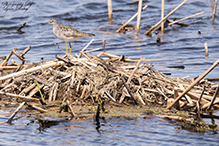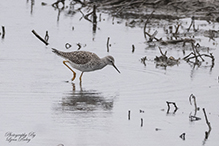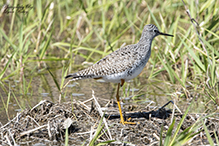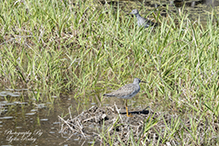Lesser Yellowlegs
(Tringa flavipes)
Conservation • Description • Habitat • Ecology • Distribution • Taxonomy
|
|
||||||||||||||
Description |
Lesser Yellowlegs is a medium-sized sandpiper. It nests in meadows and open woodlands from Alaska to Quebec, and winters mostly in South America. It is a common to locally abundant migrant throughout Minnesota from late March to early June and from July to October. In Minnesota it is found in marshes, wet meadows, mudflats, and flooded agricultural fields, and on the shores of lakes and ponds. It eats mostly flies, beetles, and other insects, but also spiders, small fish, snails, crustaceans, worms, and seeds. The population of Lesser Yellowlegs is declining due to habitat loss in part the result of climate change. However, the species range is extremely large and the species is not considered vulnerable. A Lesser Yellowlegs looks similar to a Greater Yellowlegs but is smaller. The adult is 10″ to 11″ in length and has a wingspan of 24″. It is a slender shorebird with a small head, a thin bill, and long, bright yellow legs. The nonbreeding plumage is uniformly gray on the upper side with fine, dark streaking. The underparts are white with small gray spots. There is a dark line from the bill to the eye. The bill is straight, thin, entirely black, and about the same length as the head. |
Size |
10″ to 11″ in length 24″ wingspan |
Voice |
|
|
Similar Species |
Greater Yellowlegs (Tringa melanoleuca) is larger, 13″ to 15″ in length. The bill is stouter, noticeably longer than the head, and often slightly upturned. |
|
Size |
|
Voice |
|
Similar Species |
Habitat |
Marshes, wet meadows, mudflats, flooded agricultural fields, and the shores of lakes and ponds. |
Ecology |
Migration |
Late March to early June and July to October. |
Nesting |
They nest in boreal forests from Alaska to Quebec. |
Food |
Mostly flies, beetles, and other insects, but also spiders, small fish, snails, crustaceans, worms, and seeds. |
Distribution |
Occurrence |
Common to locally abundant migrant |
Maps |
The Minnesota Ornithologists’ Union All Seasons Species Occurrence Map |
Taxonomy |
|
Class |
Aves (birds) |
Order |
Charadriiformes (shorebirds and allies) |
Family |
Scolopacidae (sandpipers and allies) |
Genus |
Tringa (shanks, tattlers, and allies) |
Subordinate Taxa |
|
|
|
Synonyms |
|
|
|
Visitor Photos |
||
Share your photo of this bird. |
||
This button not working for you? |
||
Lynn Rubey |
||
 |
||
|
||
Lesser Yellowlegs in The Big Stone National Wildlife Refuge in Lac qui Parle County, near the West Pool area. Lesser Yellowlegs foraging for food. |
 |
|
A Lesser Yellowlegs standing on one foot with one foot tucked up reducing its heat loss by half. The un feathered limbs lose body heat. These birds an adaptation called “rete mirabile” that minimizes heat loss. |
||
The arteries that transport warm blood into the legs lie in contact with the veins that return colder blood to the bird's heart. The arteries warm the veins. Because the veins also cool the arteries, the bird’s feet are closer to environmental temperature and thus don’t lose as much heat as they would if they were at body temperature. And by standing on one leg, a bird reduces by half the amount of heat lost through un-feathered limbs. |
 |
|
| A pair of Lesser Yellowlegs foraging for food in the West Pool area of the grassy marshes. |  |
|
MinnesotaSeasons.com Photos |
||
|
||
|
||

Visitor Videos |
||
Share your video of this bird. |
||
This button not working for you? |
||
|
Other Videos |
||
Lesser Yellowlegs (Tringa flavipes) at Heron's Head San Francisco |
About
Feb 7, 2014 Lesser Yellowlegs (Tringa flavipes) in San Francisco's Heron's Head Park. Though more common in the fall in wetlands further from the coast, this species is notably rare in the city. I forgot who found this, but nice find! I believe September 2012. This bird was about the size of a Killdeer, notably smaller than the more more common Greater Yellowlegs. It also has a straighter, thinner bill than a Greater Yellowlegs. I love how it perks up when the first siren blips. https://www.facebook.com/JosiahClarkNaturalist |
Lesser Yellowlegs (Tringa flavipes) |
About
Apr 29, 2018 Perry Lake, Kansas, in April when the water level is intentionally down in preparation for Spring rains. |
Greater & Lesser Yellowlegs |
About
Mar 13, 2013 Greater & Lesser Yellowlegs (Tringa melanoleuca) - By: Mark H. Vance - Be sure to check out all of Mark's bird videos at http://www.youtube.com/markinsrq5 Please subscribe if you like birds, many more great videos to come! Thanks Mark Vance The Celery Fields - Sarasota, Florida Facebook Page - https://www.facebook.com/groups/218447741581516/ Please join! |

Visitor Sightings |
||
Report a sighting of this bird. |
||
This button not working for you? |
||
| Lynn Rubey 5/11/2020 |
Location: Big Stone National Wildlife Refuge A Lesser Yellowlegs standing on one foot with one foot tucked up reducing its heat loss by half. The un feathered limbs lose body heat. These birds an adaptation called "rete mirabile" that minimizes heat loss. The arteries that transport warm blood into the legs lie in contact with the veins that return colder blood to the bird's heart. The arteries warm the veins. Because the veins also cool the arteries, the bird’s feet are closer to environmental temperature and thus don’t lose as much heat as they would if they were at body temperature. And by standing on one leg, a bird reduces by half the amount of heat lost through un-feathered limbs. |
MinnesotaSeasons.com Sightings |
||

|
Created: 6/3/2020 Last Updated: © MinnesotaSeasons.com. All rights reserved. |


